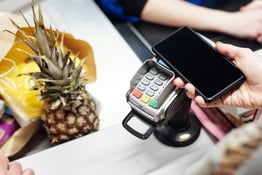A growing number of operators are enjoying the benefits of mobile payment in restaurants. Aside from the convenience of letting customers make digital payments in this increasingly digital world, mobile payment advantages for restaurants include faster, easier and more secure transactions.
Restaurants that adopt mobile payment solutions tend to see improvements in areas like turnover time, shift productivity, and sheer profitability. But how much do you really know about mobile payments, how they work, and their overall benefits for your restaurant?
Adopting Mobile Payments: Is It Worth The Hype?
A recent study on mobile payment usage shows a seven-fold increase in mobile payments over less than a decade. According to the study’s findings, just 10% of consumers had made a mobile payment in 2013. By 2022, 74% of consumers reported regularly using mobile payment methods.
The study also shows that younger consumers increasingly view mobile as the preferred method of payment because of its speed, efficiency, and security. In other words, restaurants that do not adopt mobile pay technology risk turning away customers who use this as their primary method of payment.
Understanding Mobile Payments
Mobile payment refers to the use of a digital wallet on your mobile device to complete payment transactions. Mobile payment technology is powered by something called NFC, or near-field communication. This technology enables mobile payments by allowing mobile devices and payment terminals to communicate with one another without the need for physical contact.
Customers must be able to access a digital wallet on their phone to make mobile payments. Popular digital wallets include apps like Apple Pay, Google Pay, and Samsung Pay. Users can create digital wallets by inputting their credit or debit card information into the app, where it is securely stored for later use.
To accept mobile payments, restaurant operators require a reader that is designed to enable NFC transactions. This entirely digital method of payment may not be facilitated using swipe or chip technology. Therefore, restaurants that are planning to add a mobile payment option may also need to adopt new payment terminals with NFC capabilities.
5 Mobile Payment Advantages For Restaurants
All signs point to the mainstream adoption of mobile payment technology growing in the coming years. This underscores the importance of adoption for restaurant owners.
Still on the fence? Here are five key benefits of mobile payment in restaurants to find out if this option is right for your operation:
1. Mobile payments are contactless
No touching required!
One of the key benefits of mobile payment for restaurants is its contactless technology. The NFC technology described above makes it possible for guests to complete transactions by simply opening their wallet app and holding their mobile phone over the reader.
This proved a particularly valuable option for restaurants working hard to keep customers and staff safe during the pandemic. However, Contactless payment can also help reduce the spread of germs during the annual cold and flu season, which can in turn reduce the number of shifts your employees miss due to illness.
2. Mobile payments are more secure
In the early years of digital adoption, users worried about the security of their transactions. But emergent mobile payment technology has actually proven to be far more secure than traditional credit card payment methods.
Digital wallets protect user information through something called tokenization. Tokenization means that sensitive payment information, such as credit card numbers, are replaced with randomly generated strings of characters. These character strings are unique identifiers called tokens.
Your mobile payment device uses unique tokens for each transaction, which makes your personal information unreadable to potential identity thieves and other bad actors. Mobile apps like Apple Pay also typically include additional layers of security such Facial Recognition screen locks and 2-factor authentication.
3. Mobile payments are faster
A recent article from NPR noted that the average credit card transaction is completed in roughly 40 seconds, whereas the “frictionless experience” of mobile payment takes about 30 seconds. That may not sound like a lot of time in a given transaction. But over the course of a single restaurant shift, a week of business, or a quarter of earnings, these precious seconds can add up to one of the biggest benefits of mobile payment for restaurants.
Quicker payment transactions result in faster guest turnover, higher customer satisfaction, and the opportunity to serve more diners in a single day. With mobile payments, shorter transaction times can ultimately contribute to greater profitability.
4. Mobile payments make online ordering easier
The same article from NPR said that consumers aren’t merely using mobile payments more frequently than ever. It’s also true that mobile payment options are likely contributing to more overall consumer spending.
The article estimated that roughly 4.5% of total credit card usage in the U.S. is created using mobile payment. This amounts to a $50 billion chunk of consumer spending. Experts attribute much of this spending to the ease, convenience, and constant availability of the mobile payment option. Indeed, today’s consumer is far more likely to inadvertently leave the house without a credit card than leave the room without their mobile device.
5. Mobile payments expand your customer pool
This last point underscores what may be among the most important mobile payment advantages in the coming years. Millennial and GenZ consumers increasingly prefer mobile payment options over any other method. GenX users have been slightly slower to adopt mobile payment options, the growth trajectory among users is the same. Mobile payment usage is growing rapidly among these valuable consumer demographics.
Among all three cohorts, it’s easy to envision a future in which a significant portion of consumers only carry mobile payment options. One of the core benefits of mobile payment in restaurants is that your operation will be in a position to capture their business.
Adopting New Payment Technology For Your Restaurant
Ready to adopt mobile payment technology but not sure which is the right provider for you? Book a free discovery call with a Back of House expert to get some greater insight into your options.
[Photo: Nathan Dumlao on Unsplash]





